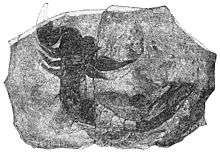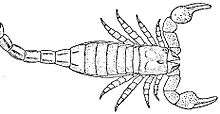Palaeophonus
Palaeophonus (meaning "ancient killer") is the oldest known genus of scorpions.[2]
| Palaeophonus | |
|---|---|
| Model of Palaeophonus nuncius | |
| Scientific classification | |
| Kingdom: | |
| Phylum: | |
| Class: | |
| Order: | |
| Suborder: | Lobosternina |
| Superfamily: | †Palaeophonoidea |
| Family: | †Palaeophonidae |
| Genus: | †Palaeophonus |
| Type species | |
| †Palaeophonus nuncius | |
Fossil records

This genus is known in the fossil record from the Silurian to the Carboniferous (age range: 428.2 to 314.6 million years ago). Fossils have been found in Europe, the United States, and Canada.[3]
Description
Palaeophonus was virtually identical to modern scorpions. It grew to a lengths of 2.5–3.5 in (64–89 mm).[4] These animals did not have eyes and therefore they were blind.[5]
Until a few decades ago, Palaeophonus, similarly to many other scorpions of the Silurian, was thought to be one of the earliest animals to have conquered the land. In fact, a closer examination of the fossils has determined that these animals possess well-developed gills, very similar to those of contemporary eurypterids (sea scorpions).[6]
Species

Species within this genus include:[3]
- †P. arctus Matthew 1894
- †P. lightbodyi Kjellesvig-Waering 1954
- †P. nuncius Thorell and Lindström 1884
- †P. osborni Whitfield 1885
References
- Laurie, M. (2012). "XIX.—On a Silurian Scorpion and some additional Eurypterid Remains from the Pentland Hills". Transactions of the Royal Society of Edinburgh. 39 (3): 575–590. doi:10.1017/S0080456800035109.
- Dunlop, J. A. (2010). "Geological history and phylogeny of Chelicerata". Arthropod Structure & Development. 39 (2–3): 124–142. doi:10.1016/j.asd.2010.01.003.
- Paleobiology Database
- G. A. Polis The Biology of scorpions
- The Eurypterida of New York Volume 1.pdf/408
- Alexander Petrunkevitch Paleozoic and Mesozoic Arachnida of Europe
- Steve Parker (2003). Dinosaurus: the Complete Guide to Dinosaurs. Firefly Books. p. 75. ISBN 978-1-55297-772-9.
- Frank H.T. Rodes, Herbert S. Zim en Paul R. Shaffer (1993) - Natuurgids Fossielen (het ontstaan, prepareren en rangschikken van fossielen), Zuidnederlandse Uitgeverij N.V., Aartselaar. ISBN D-1993-0001-361